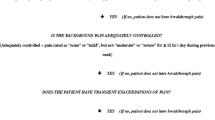Abstract
Aims
To prove if there is clinical inertia in the identification and treatment of episodes of breakthrough cancer pain (BTcP), comparing actual results from clinical practice with clinical oncologists’ prior perception.
Design
Observational and descriptive study, using information collected by practising medical oncologists, at three moments: (a) questionnaire regarding their professional judgement of the handling of patients with BTcP in their practice, (b) cross-sectional clinical screening, to detect possible existing cases of BTcP in a representative sample of their patients, (c) retrospective self-audit of clinical case histories of patients diagnosed with BTcP to find out about how it has been handled.
Participants and study period
A random sample on a state level of 108 specialists in medical oncology. 540 patients who suffer some type of cancer pain on the designated study date for each specialist (July–December 2016).
Results
The global prevalence of BTcP in the study sample covered 91.3% of the patients who were suffering some type of cancer pain. Barely 2% of the doctors surveyed suspected figures around this mark. 40.9% of the cases had not been previously detected as BTcP by their doctors. Although 90% of the patients who had previously been diagnosed with BTcP received a specific analgesic treatment for the symptoms, 42% of those patients with known BTcP were not able to control their episodes of pain.
Conclusions
Clinical inertia is a serious problem in the handling of BTcP in medical oncology services, where it is the subject of a significantly low level of detection and treatment, despite the contrasting perception of specialists.



Similar content being viewed by others
References
Breivik H, et al. Cancer-related pain: a pan-European survey of prevalence, treatment and patient attitudes. Ann Oncol. 2009;20:1420–33.
Gómez-Batiste J, et al. Breakthrough cancer pain: prevalence and characteristics in patients in Catalonia, Spain. J Pain Symptom Manage. 2002;24:45–52.
Portenoy RK, Payne D, Jacobsen P. Breakthrough pain: characteristics and impact in patients with cancer pain. Pain. 1999;81(129–34):3.
Caraceni A, Martini C, Zecca E, Portenoy RK, Ashby MA, Hawson G, et al. Breakthrough pain characteristics and síndromes in patients with cancer pain. An international survey. Palliat Med. 2004;18:177–83.
Mercadante S, Zagonel V, Breda E, Arcara C, Gebbia V, Porzio G, et al. Breakthrough pain in oncology: a longitudinal study. J Pain Symptom Manage. 2010;40:183–90.
Porta-Sales J, Garzon Rodriguez C, Julia Torras J, Casals Merchan M. Cancer-related breakthrough pain. Med Clin (Barc). 2010;135:280–5.
Mercadante S, Radbruch L, Caraceni A, Cherny N, Kaasa S, Nauck F, et al. Episodic (breakthrough) pain: consensus conference of an expert working group of the European Association for Palliative Care. Cancer. 2002;94:832–9.
O’Connor PJ, et al. Advances in patient safety, vol. 2; 2005. pp. 293–308.
Zeppetella G. Succesful management of breakthrough cáncer pain. London: Evolving Medicine Ltd; 2010.
Davies AN, Dickman A, Reid C, Stevens AM, Zeppetella G. The management of cancer-related breakthrough pain: recommendations of a task group of the Science Committee of the Association for Palliative Medicine of Great Britain and Ireland. Eur J Pain. 2009;13:331–8.
Bennett D, Burton AW, Fishman S, Fortner B, McCarberg B, Miaskowski C, et al. Consensus panel recommendations for the assessment and management of breakthrough pain. Part 1. Assessment. Pharm Ther. 2005;30:296–301.
Bennett D, Burton AW, Fishman S, Fortner B, McCarberg B, Miaskowski C, et al. Consensus panel recommendations for the assessment and management of breakthrough pain. Part 2. Management. Pharm Ther. 2005;30:354–61.
Mercadante S. The use of rapid onset opioids for breakthrough cancer pain: the challenge of its dosing. Crit Rev Oncol Hematol. 2011;80:460–5.
Escobar Y, Biete i Solà A, Camba M, Gálvez R, Mañas A, Rodríguez CA Sánchez, Rodríguez D y Tuca i Rodríguez A. Diagnóstico y tratamiento del dolor irruptivo oncológico: recomendaciones de consenso. Med Paliat. 2013;20(4):150–7.
Branch ET, Higgins S. Inercia clínica: la dificultad de superarla. Rev Esp Cardiol. 2010;63:1399–401.
Phillips LS, Branch WT, Cook CB, Doyle JP, El-Kebbi IM, Gallina DL, et al. Clinical inertia. Ann Intern Med. 2001;35:825–34.
Rivera F. Primer Plan de Futuro de la Oncología Médica. Madrid. Sociedad Española de Educación Médica, 2015. Disponible en [http://www.seom.org/ultimas-noticias/105218-primer-plan-de-futuro-de-la-oncologia-medica].
Pascual López A. Dolor irruptivo: perspectivas en cuidados paliativos. Sesiones Destacadas. V Congreso de la Sociedad Española del Dolor (Salamanca, 9–12 octubre 2002).
Zeppetella G, et al. Prevalence and characteristics of breakthrough pain in cancer patients admitted to a hospice. J Pain Symptom Manage. 2000;20:87–92.
Zeppetella G. Breakthrough pain. In: Oxford textbook of palliative medicine, 4th edn, pp. 654–661 (2010).
Portenoy RK, Hagen NA. Breakthrough pain: definition, prevalence and characteristics. Pain. 1990;41:273–81.
Acknowledgements
The Active study is a scientific initiative by the Foundation to further the Excellence and Quality of Oncology (ECO in Spanish) and the Francisco de Vitoria University in Madrid. The authors thank all of the medical oncologists who took part in the survey for their contribution to the study.
Funding
This study was funded by Kyowa Kirin Farmacéutica S.L.U., through the ECO Foundation.
Author information
Authors and Affiliations
Corresponding author
Ethics declarations
Conflict of interest
The authors declare that they have no conflict of interest.
Ethical approval
This study was realized in agreement by the ethical requirements of the declaration of Helsinki, review of Scotland (October, 2000) for the investigation by human beings.
Informed consent
All persons gave their informed consent prior to their inclusion in the study.
Rights and permissions
About this article
Cite this article
Camps Herrero, C., Reina Zoilo, J.J., Monge Martín, D. et al. Active study: undetected prevalence and clinical inertia in the treatment of breakthrough cancer pain (BTcP). Clin Transl Oncol 21, 380–390 (2019). https://doi.org/10.1007/s12094-018-1925-1
Received:
Accepted:
Published:
Issue Date:
DOI: https://doi.org/10.1007/s12094-018-1925-1




